Region: Ovens
Legal Number: LEGL/93-143/1
Plantation: Ovens
Conservation Priority: Low/High
|
 93-143 March 01: Native
vegetation within plantation surrounded by pine.
93-143 March 01: Native
vegetation within plantation surrounded by pine. |
|
Plantation within Australian Newsprint Mill (ANM) Ltd area of supply.
Plantation within Carter Holt Harvey (now owned by International
Paper) area of supply.
Plantation within Dominance Industries (Alpine MDF Industries) area
of supply.
Plantation within D & R Henderson/Monsbent area of supply.
North East Victoria Plantation
Map here
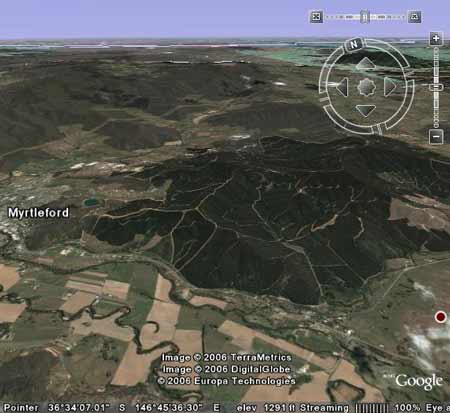
This plantation was very likely to be aerially
sprayed with 2,4,5-T between 1968 and 1977. The Dioxin TCDD may still
exist in soil in this plantation. For more historical data on 2,4,5-T
click
here. For more information concerning the
continuing health crisis concerning 2,4,5-T please forward to
here.
Herbicides Used by Hancock
in Pine Plantations - North East Region Victoria
| Herbicide |
Label Rate max as kg/ha |
Used to control |
Notes |
Application |
| Carfentrazone-Ethyl |
0.036 |
|
|
|
| Clopyralid |
2.55 |
Woody Weeds |
Highly Toxic/Potential Ground water Contaminant |
air or ground |
| Glyphosate |
3.6 |
Herbaceous and woody weeds, noxious weeds |
|
|
| Hexazinone |
4 |
Woody Weeds |
Ground Water Contaminant |
Aerial, ground, spot |
| Metsulfuron-Methyl |
0.06 |
Woody Weeds, Noxious Weeds |
Potential Ground Water Contaminant |
Aerial, ground or spot |
| Triclopyr |
3 |
Woody and Noxious Weeds |
|
Ground, spot, basal bark |
Proclaimed Water Catchment Area: This
plantation area is located in the Ovens River (Wangaratta) Water Supply
Catchment.
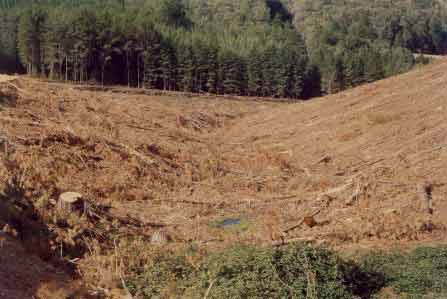
April 2003: Logging has recently
taken place in Connellys Gully. This photo shows a drainage line - clearly
marked on topographical maps - but granted no buffer protection inside
the plantation. A pool of water can be seen in the drainage line.
MURRAY RIVER SUPPLIES WATER TO YARRAWONGA, COBRAM, BARMAH, ECHUCA ,
KERANG, PIANGIL, SWAN HILL, ROBINVALE, MILDURA
THREATENED FISH NOTES - OVENS RIVER: Most important river in
Victoria in regard to the survival of the Murray
Cod. Murray
Cod spawn almost as far up as Myrtleford
and the Ovens supplies recruitment for the Murray River as well. The
Ovens has no dams and is a river of extreme national significance. Trout
Cod are now being found in the Ovens
and may set up a self sustaining spawning population. Trout
Cod have been successfully stocked into
Ovens and upper Ovens, downstream of Myrtleford and going up the King
River - past Moyhu. All the tribs of the Ovens are important for native
fish including King, Buffalo and Buckland Rivers.
Responsible Authority: Alpine Shire Council
Plantation Catchment: Headwaters and tributaries of Nil Gully/Barwidgee
Creek/Ovens River. Headwaters and tributaries of Carleys Gully/Happy
Valley Creek/Ovens River. Headwaters and tributaries of Connellys Gully/Happy
Valley Creek/Ovens River. Numerous drainages into Happy Valley Creek.
Catchment Managment Authority: North East Catchment Management
Authority
Hancock Watch site visit Mar 01: Extensive plantation taking
in whole mountainside east of Myrtleford. Saw some evidence of logging
carried some months earlier, however poor roading and steep gradiants
made access into most of the plantation very difficult. Slopes ranges
from steep to flat with little or no buffer zones on creeks evident
from our brief visit. Most of the area not logged at the moment. Some
native vegetation was evident on the plantation's eastern side. Site
Visit April 03: Recent logging had been taking place in Connellys
Gully catchment and a catchment that feeds into Happy Valley Creek.
Poor roading formation will probably mean that a large amount of sediment
may be generated off the site. Very poor buffer zones on natural drainage
lines was evident. Steep slopes had been clearfelled in the past few
months.
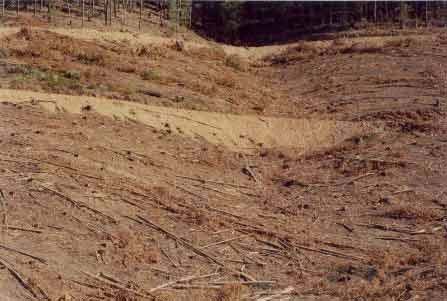
April 2003: Recent roading
extensions in the plantation showed no proper drainage and culverting.
Here is an example of poorly structured roads (Road 9). In the event
of heavy rainfall much of these roadsides will erode into the natural
drainage lines that eventually feed into Happy Valley Creek.
ôSpecial Investigation: North-Eastern Victoria - Ovens Softwood
Plantation Zone. Land Conservation Council 1981.
p11 Central Region
To the north and east of the Eastern Boundary Fault lies an extensive
area of mountainous terrain composed of Ordovician sandstones and mudstones
that are less resistant to erosion than the rocks of the south-western
region. The drainage pattern is dendritic and the streams are seperated
by sharp ridges and spurs. The mountains to the south of Mount Buffalo
are typical of this region, which extends east to Mount Beauty and north
to Myrtleford. In the north-west around Moyhu and Bobinalwarral the
ridges of Ordovician sediments become buried beneath the alluvial deposits
of the riverine plain.
Within the region, exposures of granitic rocks have intruded into the
surrounding Ordovician sediments.Intense heat associated with the intrusions
has altered (or metamorphosed) the adjacent sedimentary rocks. The granite
outcrops at Mount Buffalo and Mount Emu are extremely resistant, while
the surrounding sedimentary rocks which are less resistant have been
deeply dissected.
In contrast, the granite in the Pinnacles area to the east of Myrtleford
is more susceptible to weathering and erosion and as a consequence the
terrain in this area is more subdued. A ridge of metamorphic rocks borders
Happy Valley to the east of Myrtleford. Friable reddish and brownish
gradational soils occur on the Ordovician sediments of this region,
while the granitic rocks of Buffalo Plateau and Mount Emu exhibit a
variety of soil types. Stony loams are characteristic of rocky outcrops
while poorly drained sites contain organic loams and peats. Sandy loams
and friable gradational soils are found on the lower slopes of these
intrusions. The less resistant granitic rocks at the Pinnacles and Abbeyard
carry a variety of gradational soils on the upper slopes and a range
of duplex soils at lower elevations. The gradational soils are suitable
for softwoods, but the poorly drained duplex soils are not.
Barwidgee Creek, Myrtleford: Flows from forested country, through grazing
land and tobacco crops to join the Ovens River between Myrtleford and
Gapstead. A shallow stream with a fine gravel and sand bed. Carries
mostly brown trout to 700g, some rainbow trout to 350g, river blackfish
and some small redfin.
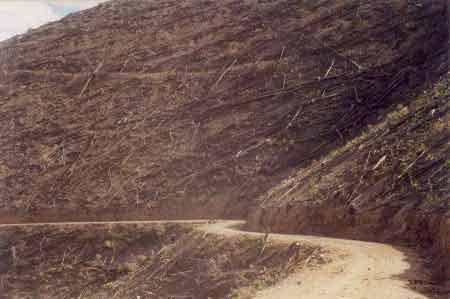
April 2003: Recently logged
plantation which drains directly into Happy Valley Creek. This shot
was taken from Road 11. Note obvious steepness of the terrain.
Happy Valley Creek, Mytrleford: A small creek flowing through grazing
land, sand bed, joining Ovens River below Myrtleford. Contains some
brown trout to 640g, and some river blackfish and redfin. Some trout
spawning occurs in the stream, and trout enter the creek from the Ovens
River.
Ovens River: The rivers all flow north, from heavily forested mountain
country through excessive river flats to the Murray River. Murray cod
populations close to the Murray River. Small river blackfish are common
in many rivers, Macquarie Perch are still occasionally caught, and catches
of golden perch are also being reported. Brown trout widely distributed
through system with rainbow trout most abundant in upper reaches. Upstream
from Myrtleford - Brown Trout to 1.3kg, some rainbow trout, small redfin
and river blackfish.
Ovens River: Upstream from Myrtleford - Brown Trout to 1.3kg, some rainbow
trout, small redfin and river blackfish.
Source: A Guide to the Inland Angling Waters of Victoria by BR Tunbridge,
PL Rogan, CA Barnham. Department Conservation and Environment. Arthur
Rylah Institute for Environmental Research, 123 Brown St, Heidelberg,
3084. (4th ed - 1991)
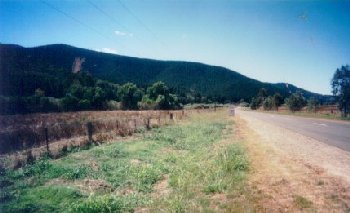 93-143: March 01: Whole
mountainside covered in pine. Massive erosion potential when harvested.
93-143: March 01: Whole
mountainside covered in pine. Massive erosion potential when harvested. |
 93-143 March 01: Inside
plantation. There are some milder slopes.
93-143 March 01: Inside
plantation. There are some milder slopes. |
 93-144: Recent pine clearance.
Northern slopes. March 01.
93-144: Recent pine clearance.
Northern slopes. March 01. |
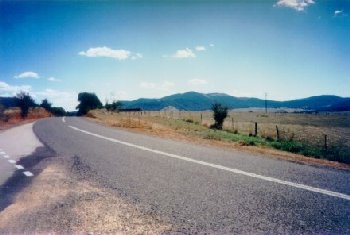 93-144 March 01: Photo taken
from north east of plantation. Whole hillside is pine.
93-144 March 01: Photo taken
from north east of plantation. Whole hillside is pine. |
HOME
|








